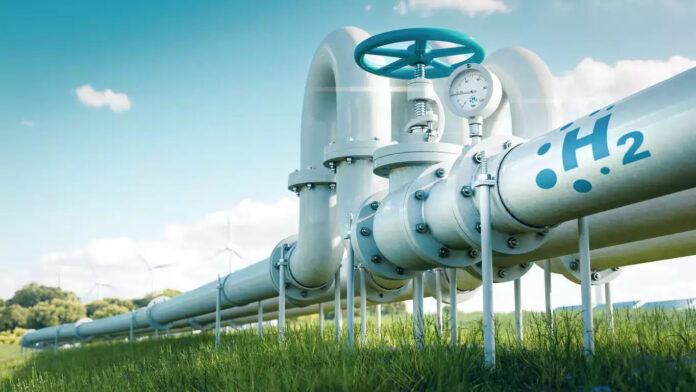Pakistan is a country that has been facing an energy crisis for several years now. It has been struggling to meet the growing demand for energy, which has resulted in load shedding and power outages. The energy crisis has not only affected the country’s economy but has also had a significant impact on the lives of ordinary people. However, the recent emergence of green hydrogen as a potential solution to the energy crisis and has opened up new opportunities for Pakistan.
Green hydrogen refers to hydrogen that is produced using renewable energy sources such as wind, solar, or hydropower. The process of producing green hydrogen involves using an electrolyzer to split water into hydrogen and oxygen, with the use of renewable energy sources to power the process. The resulting hydrogen is a clean fuel that emits only water vapor when burned, making it a valuable resource in the transition to a low-carbon economy.
The production of green hydrogen offers a new opportunity for Pakistan to address its energy crisis and reduce its dependence on fossil fuels. The country has significant potential for the production of green hydrogen, and with the right policies and investment, it can become a leader in the production and use of this clean energy resource. The development of a green hydrogen ecosystem in Pakistan can create new jobs, drive economic growth, and help the country transition to a low-carbon economy
Pakistan has significant potential for the production of green hydrogen due to its abundant solar and wind resources. The country is located in a region with high solar irradiance and has significant wind power potential, especially in the coastal areas. Pakistan can leverage these resources to produce green hydrogen and reduce its dependence on fossil fuels for energy generation.
Green hydrogen has several potential applications in Pakistan. For example, it can be used as a fuel for transportation, which is a significant contributor to the country’s carbon emissions. The use of green hydrogen in the transportation sector can help reduce these emissions and improve air quality. Additionally, green hydrogen can be used as a feedstock for industrial processes such as the production of ammonia, which is used in fertilizers.
The production of green hydrogen can also help Pakistan address its energy storage challenges. The country has been experiencing a significant increase in the use of intermittent renewable energy sources such as wind and solar, which pose challenges for the stability of the electricity grid. Green hydrogen can be used to store excess energy generated from these sources during periods of low demand, and the stored hydrogen can be used to generate electricity during periods of high demand.
Pakistan has already taken some steps towards the production of green hydrogen. The country’s first-ever green hydrogen plant was inaugurated in February 2021, with the capacity to produce 60 kg of hydrogen per day using solar energy. This plant is a significant step towards the development of a green hydrogen ecosystem in Pakistan, and it is expected to pave the way for further investment in the sector.
The production of green hydrogen has several benefits for Pakistan. First, it can help the country reduce its dependence on imported fossil fuels, which can save valuable foreign exchange reserves. Second, it can help address the country’s energy crisis by providing a clean and reliable source of energy. Finally, the production of green hydrogen can help Pakistan meet its climate change commitments under the Paris Agreement by reducing greenhouse gas emissions.
The production of green hydrogen on an industrial scale requires a coordinated effort between academia, government, and the private sector. In this section, we will discuss how academia and government can play a role in promoting the production of green hydrogen on an industrial scale.
Academia can play a critical role in advancing the technology and knowledge required for the large-scale production of green hydrogen. Research institutions and universities can conduct research on the development of more efficient electrolyzers and catalysts, as well as on the integration of renewable energy sources into the hydrogen production process. These institutions can also provide training and education to the workforce, which is critical for the development of a skilled workforce in the green hydrogen sector.
Government support is also essential for the large-scale production of green hydrogen. The government can provide policy support, incentives, and funding to encourage the development of a green hydrogen industry. This can include tax credits, grants, and low-interest loans for companies that invest in green hydrogen production. Government agencies can also work to streamline the regulatory framework for the production and use of green hydrogen, which can help to reduce costs and accelerate the development of the industry. In addition, the government can play a critical role in the development of the necessary infrastructure for the production, storage, and transportation of green hydrogen. This can include the construction of pipelines and storage facilities, as well as the development of regulations and standards for the safe transportation and use of hydrogen.
To promote the large-scale production of green hydrogen, academia and government can collaborate to establish research and development centres focused on the technology and applications of green hydrogen. These centres can bring together researchers, government agencies, and industry partners to develop and test new technologies, share best practices, and collaborate on projects aimed at accelerating the development of the green hydrogen industry.
The production of green hydrogen offers a new opportunity for Pakistan to address its energy crisis and reduce its dependence on fossil fuels. The country has significant potential for the production of green hydrogen, and with the right policies and investment, it can become a leader in the production and use of this clean energy resource. The development of a green hydrogen ecosystem in Pakistan can create new jobs, drive economic growth, and help the country transition to a low-carbon economy.






















